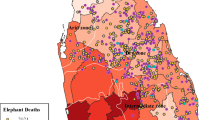Abstract
Today, armed conflict affects some twenty countries, covering an area making up 11% of the surface area of the Earth. Any degradation of nature in these areas represents a harmful depletion of the world’s natural heritage. Despite this, environmental issues are neglected during these periods of conflict, considered secondary to the urgency of restoring peace and safeguarding human life. Yet their consequences are potentially severe. In these areas, it is future generations who will suffer the effects of the current devastation for a very long time. In this context, the method developed in this study, named (Geographic Information System) for Environmental Monitoring in Wartime, can be used to calculate a risk indicator for environmental degradation, spatial monitoring and risk management. This will make it possible to identify the main threats to protected areas, catalogue the damage caused to the environment by armed conflicts and create a dynamic risk map. In this paper, GIS-EMW has been applied to calculate a risk indicator for environmental degradation in Syria.






Similar content being viewed by others
Notes
When many species are in danger of becoming extinct, when damage causes irreversible degradation of the fragile ecosystems, when natural resources are irretrievably destroyed or contaminated.
References
ACLED. Armed Conflict Location & Event Data Project. [ONLINE] Available at: https://www.acleddata.com/. Accessed 10 Decembre 2018.
Brennan Jacot, M. (2009). Les aires marines protégées comme outils de conservation de la biodiversité marine. Sherbrooke: Université de Sherbrooke.
Chechabo Baloko, B. (2011). Impact de la guerre sur l’environnement à l’est de la r.d. congo 2011 (p. 72). Nicosia: Univ Européenne.
Di Gregorio, A. (2016). Food and Agriculture Organization of the United Nations, Land Cover Classification System: Classification Concepts and User Manual : LCCS, Version 3 Food & Agriculture Org, Science - 190 pages.
FAO. 2012, (2015), Terms and definitions. Rome.
FAO. (2017), Arbres, forêts et utilisation des terres dans les zones arides : première évaluation mondiale. Rome.
Faour G., Mhawej M. and Fayad (2016). Detecting Changes in Vegetation Trends in the Middle East and North Africa (MENA) Region Using SPOT Vegetation, Cybergeo: European Journal of Geography [Online], Cartography, Images, GIS, document 779, Online since 14 April 2016, connection on 12 March 2018. https://doi.org/10.4000/cybergeo.27620
Maresca, B., Mordret, X., Ughetto, A.L. and Blancher, P. 2011. Évaluation des services rendus par les écosystèmes en France. Les enseignements d’une application du Millennium Ecosystem Assessment au territoire français, Développement durable et territoires, Vol. 2, n° 3
Mobaied, S. (2016). La nature dans les zones de conflits armés. Le cas de la Syrie, Le courrier de la Nature, 299, 42–45.
Pereira, J. M. C. (1999). A comparative evaluation of NOAA/AVHRR vegetation indexes for burned surface detection and mapping. IEEE Transactions on Geoscience and Remote Sensing, 37, 217–226.
Rameau, J.C. (1995). Définition et évaluation de la qualité d’un écosystème forestier, in : Actes du Colloque « La bioqualité dans la gestion forestière », 12 sept. (1995, LLN (Belgique), Forêt Wallonne 39/40 38–51.
Relief Works Agency (UNRWA). 2018. Map :( Camp and Informal Site Profiles Northeast Syria.
US Department of State Humanitarian Information Unit. (2014). Maps showing the location of refugee camps, [ONLINE] Available at: https://www.arcgis.com/home/item.html?id=2d256aed15224ccb89971a1b11129c18. Accessed 5 Decembre 2018.
What is copernicus? [ONLINE] Available at: https://web.archive.org/web/20181108224549/http://copernicus.eu/main/copernicus-brief. Accessed 25 August 2019.
Zwijnenburg, W. 2016. Human health and environmental risks of civilian operated makeshift oil refineries in Syria, PAX
Acknowledgements
We thank Luc Semal, researcher at the Center for Ecology and Conservation Sciences (Cesco, UMR 7204), for his suggestions that significantly contributed to improving the quality of this study. We thank the anonymous reviewers for their helpful and constructive comments that significantly contributed to improving the quality of the publication.
Author information
Authors and Affiliations
Corresponding author
Additional information
Publisher’s note
Springer Nature remains neutral with regard to jurisdictional claims in published maps and institutional affiliations.
Rights and permissions
About this article
Cite this article
Mobaied, S., Rudant, JP. New method for environmental monitoring in armed conflict zones: a case study of Syria. Environ Monit Assess 191, 643 (2019). https://doi.org/10.1007/s10661-019-7805-5
Received:
Accepted:
Published:
DOI: https://doi.org/10.1007/s10661-019-7805-5




